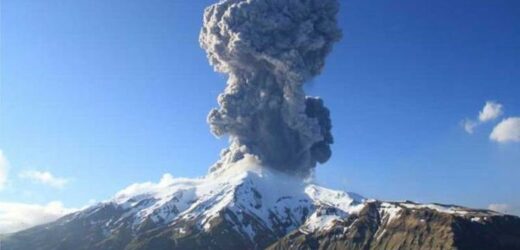Alaska volcano: Researcher warns of ash eruption threat
We use your sign-up to provide content in ways you’ve consented to and to improve our understanding of you. This may include adverts from us and 3rd parties based on our understanding. You can unsubscribe at any time. More info
The magnitude 8.2 earthquake struck the Alaskan peninsula on Wednesday, July 28, prompting fears of impending tsunami waves. Geologists are now keeping a watchful eye on another potential source of disaster – the Great Sitkin volcano. Located in the central Aleutian Islands, eastern Alaska, the volcano has been showing signs of increased activity and rising surface temperatures since January.
The Alaska Volcano Observatory (AVO) was prompted to raise the alert level for Great Sitkin in late May following an explosive eruption.
Initial reports suggested the volcano belched an ash cloud up to 15,000ft in the sky.
Geologists have now confirmed “unrest continues” at the volcano, and Great Sitkin is being monitored for another possible eruption.
The AVO reported late on Sunday, August 1, a moderate earthquake swarm struck the volcano but the seismicity has since declined.


Satellites passing over the island have also picked up light steam emissions from the volcano, which sits at an elevation of about 5709ft.
The AVO said: “Renewed explosive activity or lava effusion remain possible outcomes of the current period of unrest.
“This is not certain and a decline in unrest to background levels of activity is also possible.
“Great Sitkin volcano is monitored by local seismic and infrasound sensors, satellite data, web cameras, and remote infrasound and lightning networks.”
The nearest city, Adak, is located about 26 miles away and boasts a population of more than 300.
Alaska volcano is 10 TIMES as forceful as Mount St. Helen's
Both Adak and Great Sitkin sit in the Aleutian Islands – an archipelago of 69 islands on the border of the Bering Sea and the Pacific Ocean.
At least 14 of these islands are volcanic and form the northern edge of the Pacific Ring of Fire.
And Great Sitkin is not the only Alaskan volcano being monitored for unrest.
A volcano watch has also been issued for the Semisopochnoi volcano, which has been struck by a series of earthquakes over the weekend.
According to the AVO, small eruptions have been going off at the volcano’s north crater.


Ash clouds have also been detected up to 10,000ft above sea level.
The AVO warned: “Small explosions may occur without warning and could be undetected by region infrasound sensors and cloudy weather conditions.”
The Aleutian Islands may also be another source of worry for the US state.
According to the American Geophysical Union, six of the archipelago’s volcanoes may be part of a larger, underwater caldera.
Evidence has been put forward to suggest the volcanoes Carlisle, Cleveland, Herbert, Kagamil, Tana and Uliag are being fuelled by a bigger source than previously thought.
Diana Roman, who co-authored a study on the possible supervolcano, said: “Everything we look at lines up with a caldera in this region.”
Scientists have warned last month about the need to monitor the world’s supervolcanoes for signs of unrest.
An expert involved in the study told Express.co.uk there are no agreed-upon indicators of an impending super-eruption – and that needs to urgently change.
Dr George Cooper, from Cardiff University’s School of Earth and Environmental Sciences, said: “Careful monitoring of these systems needs to be carried out to better understand the processes occurring at depth beneath the volcano.”
Source: Read Full Article


